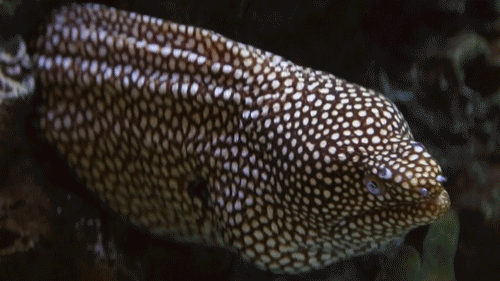 Picmiz's Aquarium
Picmiz's Aquarium 
The moray eel
Moray eels, or muraenidae, is a family of eels belonging to the order anguilliformes. Moray eels are true eels.
There are 16 moray eel genera and around 200 species, most of which can be found in tropical and subtropical waters. Moray eels can be found in saltwater, freshwater, and brackish water, however they are most commonly found in the ocean. They live in coral reefs and rocky environments with lots of hiding spots. They are ambush hunters, meaning they hide in crevices and wait to surprise attack prey! Even when they are not hunting, they enjoy resting among the rocks. Despite their reputation of being ferocious, aggressive fish... moray eels are actually quite shy! They usually do not attack humans unprovoked, and will prefer to retreat into a hiding spot than comfront us. They are also incredibly intelligent!
Moray eels come in a wide range of colours, sizes, and lengths. They typically range between 3-5ft, but species such as G. javanicus or S. sathete can grow over 10ft long! The former is the worlds largest moray eel, weighing around 66lbs, while the latter is the world's longest moray eel, being able to attain 13ft long.

Moray eels have two sets of jaws, and two sets of nostrils!
Moray eels, like many fish, do not have great vision. Even species like the chestnut moray eel can't see well, even with those huge eyes! To help sense their surroundings, moray eels have something called nares located on the tip of their snout and above the eyes. Nares work similarly to our nostrils, but they aren't used to breathe. Their sole function is helping moray eels smell! On some species such as the dragon moray eel, their second set of nares are elongated and tubular, making them very easy to spot. They are easily mistaken for horns! On other species they are more difficult to spot, but all morays have them.

Moray eels start life as a larvae!
No, moray eels aren't bugs, silly! Amphibians and marine life can also start life in a larval stage. Moray eels belong to the superorder Elopomorpha, which contains all fish that are born as larvae. In this stage of their life, the skin of the baby moray eel lacks pigment, making their bodies translucent, like glass! The fancy name for an eel larvae is a leptocephalus. They are TINY!
It should be noted that the term "glass eel" DOES refer to a baby eel larvae, but it seems like it is exclusively for freshwater eels like the American eel. Also, yes! ALL eel species start as larvae, not just morays. :)

Not all morays have sharp teeth.
Many moray eels have teeth made to rip and tear flesh, perfect for eating fish. However, members of the genus Echidna (and gymnomuraena) possess blunt, plate-like teeth that are designed to crush shells. These eels have a diet that consists largely of bivalves and mollusks, so sharp teeth would be no use to them!

Moray eels are mouth breathers!
You may have noticed that moray eels do not have the same kind of gills most fish typically have. In other words, they lack gill covers. You see, moray eels do not spend a lot of time moving. Many fish rely on movement to pass water through their gills, which gives them oxygen, but if you spend most of your day hiding in a crevice... what use is that? Instead, moray eels use their mouths to pump water into their bodies, which then pass through their gills and exit from two little gill openings behind their head. This is called buccal pumping. Many sedate sea creatures use this metheod of breathing, such as the nurse shark!


Moray eels do coopertive hunting.
When I said morays are intelligent, I meant it. Moray eels have been spotted on numerous occasions hunting alongside various species of groupers while hunting. It seems that the grouper locates prey, while the moray drives it out of its hiding spot. Together, the two fish would have a higher success rate than if they both hunted alone. (Though... moray eels don't really hunt, do they?)

Some genera only have one member.
Gymnothorax, Enchelycore, Muraena, and Echidna all contain plenty of species, they are among the larger genera for moray eels. However there are a handful of genera such as Gymnomuraena, Rhinomuraena, Monopenchelys, and Enchelynassa with no more than one species. These are the zebra moray, ribbon moray, redface moray and viper moray respectively. The zebra moray used to be grouped in with Echidna and some still consider it a member of that genus.

Morays enjoy company.
Although some species are more reclused than others, morays are surprisingly social! They are not considered social animals by definition but it is not uncommon to see a group of three, four, even five morays hanging out in the same crevice! Species such as Gymnothorax thyrsoideus form these groups very often. Additionally, it is not uncommon for moray masses to consist of multiple species, even members of different genera!

Moray eels have multiple rows of teeth.
In some genera, morays can have up to 4 rows of teeth on their upper jaw. This is the reason why it appears they have a single tooth in some photos, it is actually just the first tooth in their third or even fourth row of teeth in the centre of their mouth! This helps them grasp prey.